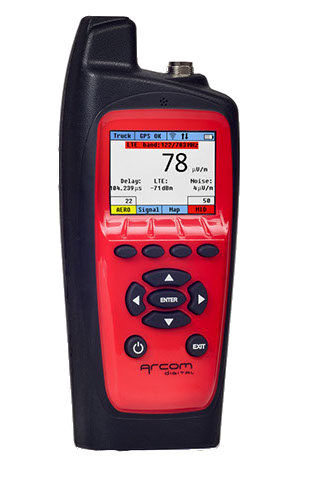Identifying the causes of network impairments and being able to pinpoint their locations are key to eliminating them. Arcom Quiver® is the only field-troubleshooting tool that can do just that.
The unique power of Quiver comes from Arcom Digital patented Xcor® technology, which uses advanced passive radar signal correlation to measure the presence of Common Path Distortion (CPD) and any other non-linear distortion.
CPD will not fix itself.
Quiver – a hand-held device – allows technicians to consistently detect well below the system noise floor, revealing impairments previously invisible or intermittent.

**************
Explainer to Image:
Identifying the causes of network impairments and being able to pinpoint
their locations are key to eliminating them. Quiver is the only field-troubleshooting tool that can do just that.
Quiver boosts your productivity by determining the precise distance to a problem source, eliminating hours of guesswork. More importantly (especially to your customers) your technicians can identify and locate issues without ever disturbing your network.
Innovation in High-Split and FDX Leakage Detection by Sensing OUDP
Traditional RF leakage test systems leverage downstream signal sources that typically emanate from the headend/hub today. In a high-split architecture the 108 MHz to 137 MHz aeronautical band is now in the upstream path.
In USA, compliance with FCC requirements means maintaining the existing 138 MHz monitoring location above 860 MHz, and also maintaining the visibility to trouble-shoot harmful interference issues with 4G LTE (fourth generation Long Term Evolution) service providers.
Arcom pioneered with Comcast Corporation this capability and patented the OFDMA upstream data profile (OUDP) detection approach which has become the de facto standard for upstream leakage in high-split and FDX networks.
Under control of the CCAP, the DOCSIS 3.1 cable modem generates a burst test signal with known characteristics. The Arcom QAM Snare detectors uses advanced signal processing techniques to resolve and capture the burst signal – confirming the presence of a leak. The exact GPS co-ordinates of the leak and the source magnitude can be calculated in near real-time.
It’s better to know the difference between urgent and important
QAM Snare provides a mechanism to intelligently prioritise repairs – saving you time and resources and increasing customer satisfaction.
It’s better to avoid obsolescence
Unlike other commercially available technologies that attempt to detect carriers inserted between QAM channels, Snare is compatible with QAM, OFDM, OFDMA and analogue modulation formats is also ready today for high-split and FDX networks – ensuring your investment today will still work in years to come.
For all your OUDP information needs, speak to C-COR for a seamless off-the-shelf solution.
For direct advice, call Richard Goddard on +61 3 9241 8917 for an obligation free consultation or click Leakage Detection.
